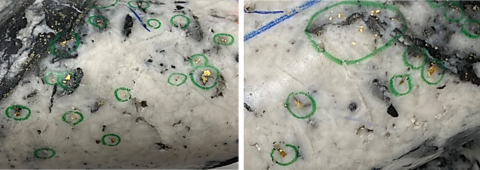New Found Intercepts 89.5 g/t Au Over 2.00m in New “Tuesday” Zone Discovery at Lotto

Figure 1. Photo of mineralization from NFGC-22-552 at approximately 88.4m down hole depth. ^Note that these photos are not intended to be representative of gold mineralization in hole NFGC-22-552. (Photo: Business Wire)
Highlight:
Hole No. |
From (m) |
To (m) |
Interval (m)1 |
Au (g/t) |
NFGC-22-552 |
87.95 |
89.95 |
2.00 |
89.5 |
Including |
88.35 |
88.75 |
0.40 |
442 |
Table 1: Tuesday Drilling Highlight
1Note that the host structures are interpreted to be steeply dipping and true widths are unknown at this time. Infill veining in secondary structures with multiple orientations crosscutting the primary host structures are commonly observed in drill core which could result in additional uncertainty in true width. Composite intervals reported carry a minimum weighted average of 1 g/t Au diluted over a minimum core length of 2m with a maximum of 2m consecutive dilution. Included high-grade intercepts are reported as any consecutive interval with grades greater than 10 g/t Au. Grades have not been capped in the averaging and intervals are reported as drill thickness.
- At the Lotto prospect, drill testing in the area between the “Lotto Main” vein and the AFZ, intersected a new high-grade zone that returned 89.5 g/t Au over 2.00m in NFGC-22-552 that is 55m below surface, named the “Tuesday” Zone (Figures 2 and 3).
-
The
Tuesday Zone is located in a similar stratigraphic position as theSunday Zone which is 80m north in the footwall to the AFZ where hole NFGC-20-44 returned 18.1 g/t Au over 6.50m (seeJanuary 14, 2021 news release), and NFGC-21-319 returned 23.1 g/t Au over 2.05m (seeMarch 24, 2022 news release). The newTuesday Zone is interpreted to comprise part of the network of high-grade veins and associated faults developed within the footwall to the AFZ occurring at an intersection between two differently oriented vein-trends (Figures 2 and 3), with mineralization remaining open in all directions.
Discussion
Mineralization at the
As a result of progressive deformation, the brittle host stratigraphy developed an extensive network of gold-bearing fault zones enveloping the AFZ, the extents of which are not yet known. This structural relationship is illustrated in Figure 2 and demonstrates the currently defined vein and associated fault orientations based on structural interpretation and drilling to date along the 1km corridor from Keats to Lotto. Higher grades and widths of gold mineralization occur in areas where there was greater mineralizing fluid flow such as at structural intersections, at dilational openings within fault structures, and along lithological contacts where breakage occurs due to rheological differences in the compressional strength of contrasting sedimentary rock units. A significant amount of the high-grade gold mineralization intercepted in drilling to date is interpreted to be epizonal in nature, having been emplaced when tectonic movements resulted in the explosive tapping of deep gold-rich magmatic fluids that rapidly precipitated gold as they migrated towards surface.
Drillhole Details
Hole No. |
From (m) |
To (m) |
Interval (m)1 |
Au (g/t) |
NFGC-22-552 |
87.95 |
89.95 |
2.00 |
89.5 |
Including |
88.35 |
88.75 |
0.40 |
442 |
Table 2: Summary of composite results reported in this release for
1Note that the host structures are interpreted to be steeply dipping and true widths are unknown at this time. Infill veining in secondary structures with multiple orientations crosscutting the primary host structures are commonly observed in drill core which could result in additional uncertainty in true width. Composite intervals reported carry a minimum weighted average of 1 g/t Au diluted over a minimum core length of 2m with a maximum of 2m consecutive dilution. Included high-grade intercepts are reported as any consecutive interval with grades greater than 10 g/t Au. Grades have not been capped in the averaging and intervals are reported as drill thickness.
Hole No. |
Azimuth (°) |
Dip (°) |
Length (m) |
UTM E |
UTM N |
NFGC-22-552 |
300 |
-45 |
201 |
658833 |
5429014 |
Table 3: Details of drill holes reported in this release
Queensway 400,000m Drill Program Update
Approximately
Sampling, Sub-sampling, Laboratory, and Discussion
True widths of the intercepts reported in this press release have yet to be determined and further exploration is required. Infill veining in secondary structures with multiple orientations crosscutting the primary host structures are commonly observed in drill core which could result in additional variability in true width. Assays are uncut, and composite intervals are calculated using a minimum weighted average of 1 g/t Au diluted over a minimum core length of 2m with a maximum of 2m consecutive dilution. Included high-grade intercepts are reported as any consecutive interval with grades greater than 10 g/t Au.
All drilling recovers HQ core. Drill core is split in half using a diamond saw or a hydraulic splitter for rare intersections with incompetent core.
A professional geologist examines the drill core and marks out the intervals to be sampled and the cutting line. Sample lengths are mostly 1.0 meter and adjusted to respect lithological and/or mineralogical contacts and isolate narrow (<1.0m) veins or other structures that may yield higher grades. Once all sample intervals have been chosen, photos of the wet and dry core are taken for future reference.
Technicians saw the core along the defined cut-line. One-half of the core is kept as a witness sample and the other half is submitted for crushing, pulverizing, and assaying. Individual sample bags are sealed and placed into shipping pails and/or nylon shipping bags, sealed, and marked with the contents.
Drill core samples are shipped to
The entire sample is crushed to approximately
Samples that have VG identified or fall within a mineralized interval are automatically submitted for screened metallic assay for gold.
All sample pulps are also analyzed for a multi-element ICP package (ALS method code ICP61).
Drill program design, Quality Assurance/Quality Control, and interpretation of results are performed by qualified persons employing a rigorous Quality Assurance/Quality Control program consistent with industry best practices. Standards and blanks account for a minimum of
Quality Control data are evaluated on receipt from the laboratories for failures. Appropriate action is taken if assay results for standards and blanks fall outside allowed tolerances. All results stated have passed New Found’s quality control protocols.
New Found’s quality control program also includes submission of the second half of the core for approximately
The Company does not recognize any factors of drilling, sampling, or recovery that could materially affect the accuracy or reliability of the assay data disclosed.
The assay data disclosed in this news release have been verified by the Company’s Qualified Person against the original assay certificates.
The Company notes that it has not completed any economic evaluations of its
Qualified Person
The technical content disclosed in this press release was reviewed and approved by
About
New Found holds a
Please see the Company’s website at www.newfoundgold.ca and the Company’s SEDAR profile at www.sedar.com.
Acknowledgements
New Found acknowledges the financial support of the
Contact
To contact the Company, please visit the Company’s website, www.newfoundgold.ca and make your request through our investor inquiry form. Our management has a pledge to be in touch with any investor inquiries within 24 hours.
Neither the
Forward-Looking Statement Cautions
This press release contains certain "forward-looking statements" within the meaning of Canadian securities legislation, relating to assay results, exploration and drilling on the Company’s Queensway gold project in
View source version on businesswire.com: https://www.businesswire.com/news/home/20220608005421/en/
Per: "Collin Kettell"
Email: ckettell@newfoundgold.ca
Phone: +1 (845) 535-1486
Source:







